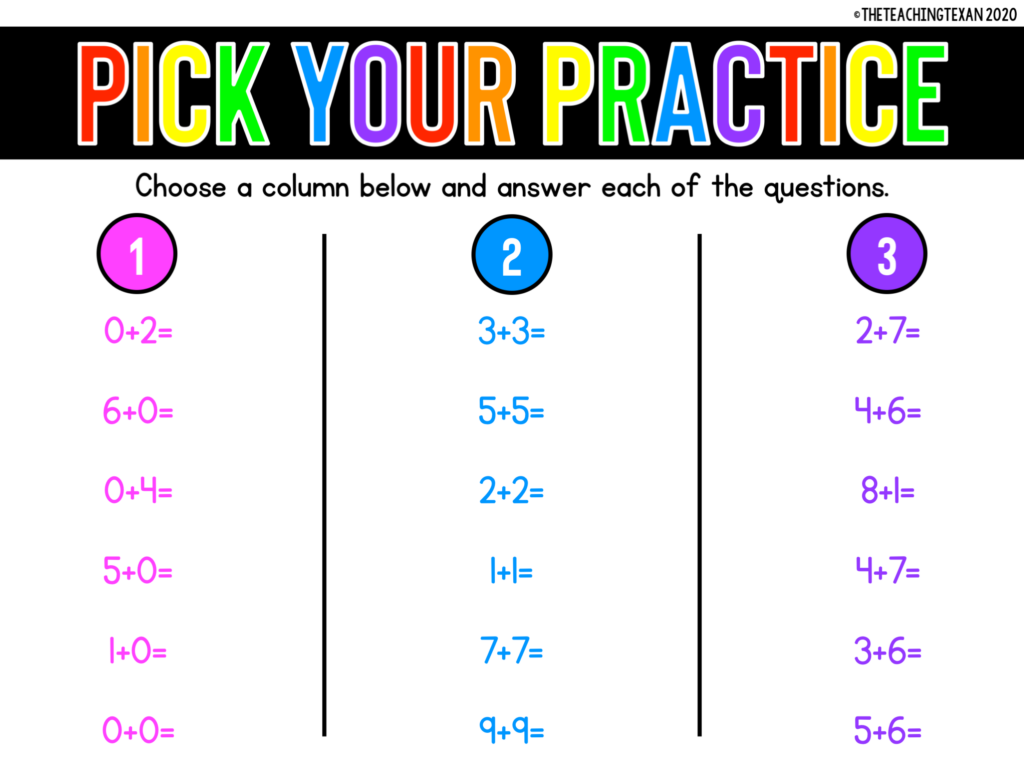Math: Let’s Warm Up!
As educators, we spend a lot of time and effort working on fluency for our students in literacy. We focus on getting them to certain reading levels, and locking those sight words in their brains for immediate recognition. Often with all this focus on literacy, we often (inadvertently) forget about the importance of MATH fluency as well.
Last post we spoke about the importance of calendar math, which can be a great way to start the day, establish routine, and get your kiddo’s brains in gear. On top of this, I’m a huge proponent for additional math warm-ups during your designated math block.

How long should my warm-up be?
Depending on your schedule and the length of your classes, you’ll spend varying amounts of time on your warm-up as opposed to centers (more on math centers in the next few weeks!) or your lesson that day. I recommend no more than 10% of your lesson block be spent on a warm-up. Meaning, if you’ve got 30 minutes for math, you can knock out a warm-up in 3 minutes or less. Sounds too short? I’ll show you some quick strategies for math warm-ups.
Of course, when establishing a math warm-up routine, you may need a bit more than 3 minutes to give instructions and ensure student comprehension, but once students learn a few activities, they’ll be able to quickly jump on board and even get excited about this quick “fire drill-type” activity. Because honestly that’s one of the biggest challenges with math warm-ups (and sometimes math in general), students find it boring or rote and are quick to disengage when they aren’t having fun.
That’s where we come in — making math fun since the dawn of education! I encourage you to focus on the game aspect of math warm-ups, instead of making them another “lesson”. We know how much kiddos love games as opposed to “work” and this is just another opportunity to make learning fun.

In my recent calendar math post we spoke about “Take Down”, one of my favorite warm-up games for kindergarten and first grade. It’s quick and easy and kids love to play it. Plus, it gives your students a chance to practice being “good losers” as there’s no skill to winning. Additionally, I love when kids who are already “out” sit in the circle and count along with those still playing. They’ll start to count ahead and predict who will be out next, which is another great skill they’re engaging — prediction!
Another quick and easy math warm-up I love (and kids do too), is a few rounds of Super Sundae Math Facts. Effective, ice cream-themed math fluency? Who doesn’t love that!?

Spiral those Skills!
Another thing to focus on during math warm-ups is spiraling skills they’ve learned before. While you may teach and introduce new games or activities for warm-ups, I’d stay away from teaching new skills or ideas during this time. Students should feel successful and smart at the end of the warm-up, not frustrated they aren’t quickly grasping a new concept. This helps them go into the rest of your math lesson with a positive and “can do” attitude, which is exactly what we want!
Tips and Tricks
- Group Activities
Whatever activity you choose, try not to single out any one student but stick to a group participation mentality. This isn’t the right time for students to feel “on the spot” in front of their peers.
- White Board
A great way to get everyone involved from their seats is to use small white boards for students to give quick answers. My students LOVE using their personal white boards and getting to use the dry erase markers makes them feel like a teacher so I bring these out as much as possible. They can quickly write and show answers to me then erase easily so when they do make mistakes it’s over and done with right away. No biggie, they can just move on to the next question.
- Pair and Share
Another great way to warm-up is having students paired up and sharing their answers with each other. If they get something different, they’ll have to explain why and eventually (hopefully) come to the right answer as a team. You can use this opportunity to pair students of the same level so they can challenge each other OR students of varying levels so one can help the other and gets an opportunity to be the “expert”. Be wary of doing this too often as kids can be quick to label each other as “good at math” or “bad at math” and we don’t want them to put themselves or each other in limiting boxes!
- Take Notes
When students are paired up, you’ve got a great opportunity to informally assess them and jot down a few notes. This will help greatly when doing formal assessments throughout the year and when deciding what to include in your math centers as you’ll already know what skills students are struggling with.
- Friday Favorites
On Fridays (or any old day you please because you’re a fun teacher!) I like to use our warm-up time to pull out a “crowd favorite” for students to play. They love it and they’re learning!
To Differentiate or No?
There will definitely be DIFFering (see what I did there?) opinions on this one, but I say go for it whenever possible. Leveling your math warm-up gives you an opportunity to, as mentioned above, informally assess students quickly and daily. An easy way to do this is with one PowerPoint or Google Slide with 3 columns. I like to include several questions in each column. This way you can offer students (in pairs or as a whole group answering on their individual white boards) three levels of difficulty or options to answer to see who’s ready for new skills, who’s up for a challenge, and who’s still hesitant or lacking confidence.

And heck, these can even be used as an early finisher option!
And guess what? I created a FREE template for you!

In fact, I’ve got a LOT of free resources for you because I’m all about working smarter not harder. Join my newsletter list below and you’ll receive access to the freebie section of The Teaching Texan website where the Addition & Subtraction Warm-Up Template and other freebies are housed.
Remember friends, the sooner in the year you establish math warm-ups, the quicker and easier they will become for students. Plus, hopefully they’ll learn to be excited and energized by math for years to come and parents will be calling you teacher and educator of the year in no time!

